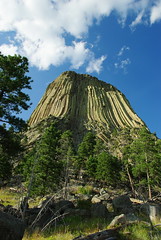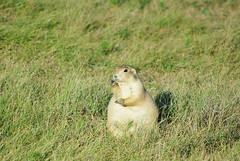Interning for the Chicago Botanical Gardens has been and is continuing to be an amazing experience for me. I have been hiking ridge tops in order to survey a rare plant, the tufted twinpod (Physaria condensate), that lives within Fossil Butte National Monument.  Not much is known about this special plant so it is rewarding to be the one to collect this baseline data. This data will be compared with elk data that is also being collected, in order to see if rising elk populations are affecting these small plants. Due to this internship I have decided that I want a career relating to fieldwork, whether it is baseline data collection or monitoring and follow-up. Being in the field gathering data is a gratifying experience because it really feels like I am making a difference. With the data I collected this summer and fall, along with data that will continued to be collected in the following summers, an EIS might be needed to control the rising elk population and my data will be part of that decision.
Not much is known about this special plant so it is rewarding to be the one to collect this baseline data. This data will be compared with elk data that is also being collected, in order to see if rising elk populations are affecting these small plants. Due to this internship I have decided that I want a career relating to fieldwork, whether it is baseline data collection or monitoring and follow-up. Being in the field gathering data is a gratifying experience because it really feels like I am making a difference. With the data I collected this summer and fall, along with data that will continued to be collected in the following summers, an EIS might be needed to control the rising elk population and my data will be part of that decision.
My adventures include wandering the park all by my lonesome looking for the tufted twinpod, with a GPS, antenna, and 2x.5m long PVC rectangular pipe. I often find myself off in the middle of no ware with no idea which way I was supposed to be going and where I came from. It’s a good thing I have my GPS, though it always says I’m going north even when I’m defiantly not. The hardest part of my job is actually located my plants and plots where my plants are not supposed to be. I have been stuck 3 times because I have to drive this really poor two-track roads in a little 2-wheel drive ford ranger. It doesn’t have very good clearance and it doesn’t like mud.
Due to the fact that I am mostly working by myself, I have gained great self discipline. It is very important to be focused and organized in order to get everything completed in a timely fashion, especially with the consent threat of snow these days. This internship has allowed me to incorporate the knowledge I gained from college into an actual job. I have been able to achieve greater understanding of GIS (using ArcInfo) as well as becoming a pro at the Magellan GPS units. I have been learning how to identify plants and other key elements in the surrounding areas.
Over all I have to say that has been great getting to know all the amazing people that work at Fossil Butte. Throughout t he summer other interns have come and gone and it has been nice to make new friends and feel like I am a part of something bigger then myself. I also got to go on many different field trips like this one to big spring. Being able to spend my summer doing worthy work and hiking in the natural environment is a wonderful experience. Given the change I would do it all over again and who knows maybe I will.
he summer other interns have come and gone and it has been nice to make new friends and feel like I am a part of something bigger then myself. I also got to go on many different field trips like this one to big spring. Being able to spend my summer doing worthy work and hiking in the natural environment is a wonderful experience. Given the change I would do it all over again and who knows maybe I will.
Lea Shaw-Messina, Fossil Butte National Monument, Wyoming





































